On the menu: variety, colours, and flavours
![]() Enjoy filling your plate with a variety of colourful and flavourful foods.
Enjoy filling your plate with a variety of colourful and flavourful foods.
Vegetables, fruits, whole grain foods, and protein foods are all important parts of a healthy diet during pregnancy. Each of these food groups provides different nutritional benefits, providing you with energy, helping your baby develop, or keeping you healthy throughout your pregnancy.
The Food Guide Snapshot can serve as an example when you’re preparing your meals. The food groups in the guide are presented in the following pages. For more information, go to food-guide.canada.ca/en/food-guide-snapshot.
Food Guide Snapshot
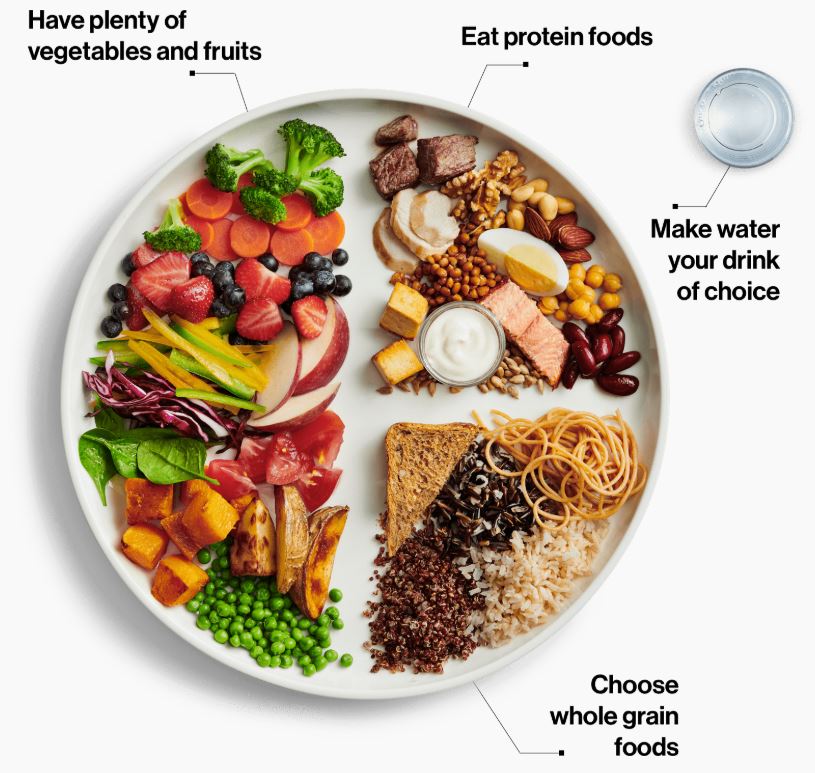
Vegetables and fruits

![]() Choose vegetables and fruits in a variety of colours, as they are rich in different nutrients.
Choose vegetables and fruits in a variety of colours, as they are rich in different nutrients.
Colourful vegetables and fruits make a crunchy and flavourful addition to your meals. It’s recommended that you incorporate them into all your meals and snacks.
You can get your veggies and fruits in different forms: fresh, frozen, canned, dried, or in sauces and compotes. They’re easy to steam, stir-fry, or cook in the oven, and they go great in soups, cooked dishes, smoothies, and desserts.
Veggies and fruits are also rich in nutrients, including fibre (see Fibre), folic acid (see Folic acid), and vitamin C. Their colour indicates what kind of nutrients they contain. That’s why it is recommended to eat a variety of different coloured veggies and fruits.
To make the most of their benefits, try to eat one dark green and one orange vegetable every day: e.g., broccoli, spinach, romaine lettuce, carrots, sweet potatoes, and winter squash.
A few tips
- If you’re not used to eating veggies and fruits at every meal, start by adding them in small quantities. Choose the ones you like the most first, then try new ones and find different ways to cook them.
- Some veggies and fruits may be more affordable to purchase frozen or canned, especially in winter. Choose the ones that have less salt and sugar.
- Vegetable and fruit juices often contain a lot of salt and sugar, and no fibre. It’s better to get your veggies and fruit in other forms.
Good to know...
Most of the fibre, vitamins, and minerals in potatoes are found in the skin. Brush them clean with a vegetable brush, cook them, and eat them with the skin on!
Whole grain foods

![]() Whole grain foods supply the energy you need to stay on your toes throughout the day.
Whole grain foods supply the energy you need to stay on your toes throughout the day.
Whole grain foods are one of the main sources of food energy. That’s why they’re recommended with every meal.
Whole grain foods include whole grain bread, pasta and breakfast cereal; oatmeal; brown rice; and any food made from whole grain flour. There are all kinds of whole grains you can try that can add variety to your meals, such as hulled barley, buckwheat, rye, millet, quinoa, wild rice, spelt, and kamut.
Whole grain foods are rich in nutrients, including carbohydrates, fibre (see Fibre) and many vitamins and minerals.
A few tips
- If you’re not used to eating whole grain foods, add them gradually to your diet. To start, you can aim to make half of the grain products you eat whole grain.
![]() When you choose whole grain foods, check the ingredients. The first item on the list must include the words “whole” or “whole grain.”
When you choose whole grain foods, check the ingredients. The first item on the list must include the words “whole” or “whole grain.”
Protein foods
During pregnancy, proteins help the baby’s organs and muscles develop. Protein foods also help to keep you energized between meals and throughout the day. That’s why it’s important to include them in every meal and snack.
Many foods contain proteins. These foods are described in the following pages. Choose plant-based protein foods on a regular basis, including legumes, nuts, seeds, and soy products like tofu.
Dairy products
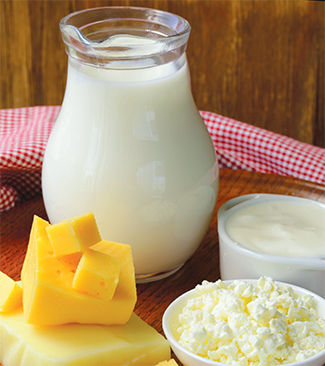
![]() Dairy products and fortified soy beverages help make bones strong.
Dairy products and fortified soy beverages help make bones strong.
In addition to proteins, dairy products like milk, cheese, and yogurt contain calcium and phosphorus, which are vital to building your baby’s bones and teeth.
Milk also contains vitamin D, which helps your body absorb and use calcium.
Milk and dairy products are easy to add to meals and snacks. For example, you can:
- Supplement meals and snacks with milk, yogurt, or cheese, based on what you like best.
- Enjoy milk or yogurt in your cold cereal at breakfast or at snack time.
- Replace water with milk when preparing hot cereals such as oatmeal or cream of wheat.
- Use milk and dairy products in cream soups, gratins, salads, blancmange, béchamel sauce, omelettes, puddings, tapioca, and smoothies.
Opt for dairy products with less fat, sugar, and salt.
Are you lactose intolerant?
Lactose-free milk, yogurt, and cheese are available in most grocery stores. You can also find tablets and drops that help digest dairy products. Ask your pharmacist for advice. You can also opt for fortified soy beverage, which doesn’t contain lactose.
Fortified soy beverages, tofu, and other soy products
Fortified soy beverages contain calcium and vitamin D, and just as much protein as milk. Opt for plain or unsweetened fortified soy beverages.
Most other plant-based beverages (e.g., almond, hemp, or rice beverage) contain little or no protein.
Soy products like soybeans (edamame) and tofu are a good way to add variety to your diet. For example, you can use tofu like meat or poultry in most recipes.
Legumes, nuts, and seeds
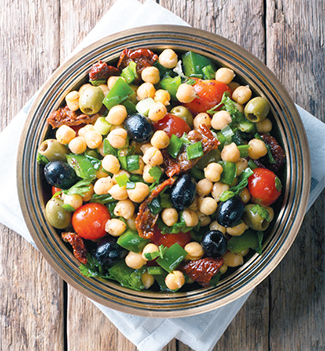
![]() Legumes like lentils, chickpeas, and beans are affordable and nutritious foods.
Legumes like lentils, chickpeas, and beans are affordable and nutritious foods.
Legumes, nuts and seeds are nutritious foods that are appealing for their flavour and variety. These plant-based protein foods are also rich in fibre.
Legumes such as lentils, chickpeas and beans are both environmentally friendly and inexpensive, and can be regularly included in your diet. They make an easy addition to soups, salads and stewed dishes, for example.
Eggs
Eggs are nutritious, practical, and inexpensive. In addition to protein, they also contain choline, which helps develop your baby’s brain and tissues, and vitamin D.
Meat, game, and poultry
In addition to protein, meat, game and poultry are a good source of iron, which contributes to blood formation and the growth of the baby and placenta.
A few precautions
- While liver is an excellent source of iron, it is not recommended for pregnant women because it is too high in vitamin A.
- If you eat wild game, it’s preferable to eat meat from game killed with lead-free ammunition. Lead can negatively affect children’s development.
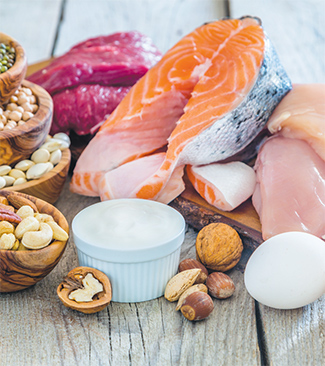
![]() Protein foods are nutritious and help keep you energized throughout the day. Vary them from meal to meal, and don’t hesitate to give new ones a try.
Protein foods are nutritious and help keep you energized throughout the day. Vary them from meal to meal, and don’t hesitate to give new ones a try.
Fish and seafood
Eating fish and seafood during pregnancy provides important nutrients, including protein, vitamin D, magnesium, and iron. Oily fish such as fresh, frozen, or canned salmon, mackerel, herring, sardines and lake whitefish are also high in omega-3 fatty acids, which contribute to the development of your baby’s brain and eyes.
Good to know...
Two meals of oily fish per week provide you with all the omega-3s you need to meet you and your baby’s needs.
A few precautions
Some species of fish contain contaminants such as mercury. Women who are pregnant or plan to become pregnant, women who are breastfeeding, and young children can still enjoy fish if it is chosen carefully.
To limit exposure to contaminants:
- Opt for fish and seafood that are low in mercury and other contaminants: shad, smelt, trout (except lake trout), Arctic char, Atlantic tomcod, salmon, lake white fish, haddock, anchovies, capelin, halibut, pollock (Boston bluefish), herring, mackerel, hake, flounder, sole, sardines, redfish, canned light tuna, tilapia, oysters, mussels, clams, scallops, crab, shrimp, and lobster.
- Limit your consumption of
- Certain marine fish (fresh or frozen tuna, shark, swordfish, marlin, and orange roughy) to 150 grams of cooked fish per month (75 grams per month for children 1 to 4 years old).
- Canned white tuna to 300 grams per week (about two normal-sized cans). Canned light tuna is a better choice. For children, see Fish.
- Avoid regular consumption of fish most vulnerable to contamination: bass, pike, walleye, muskellunge, and lake trout.
Nutritious snack ideas
Eating snacks between meals can help you get all the nutrients you need. When you choose a snack, try to combine different foods, like in these examples:
- Veggies or fruits with cottage cheese or a piece of cheese
- Greek yogurt with fruits, granola, or nuts
- A slice of bread with peanut butter and banana
- Whole-wheat pita with hummus (chickpea spread)
- A bowl of cereal with milk, a fortified soy beverage, or yogurt
- Vegetable and soybean (edamame) salad
- Mixed nuts, seeds, and dried fruits
- Crackers with salmon spread
- A fruit smoothie
- A hardboiled egg with bell pepper slices and crackers.
For more snack ideas, go to food-guide.canada.ca/en/tips-for-healthy-eating/healthy-snacks.
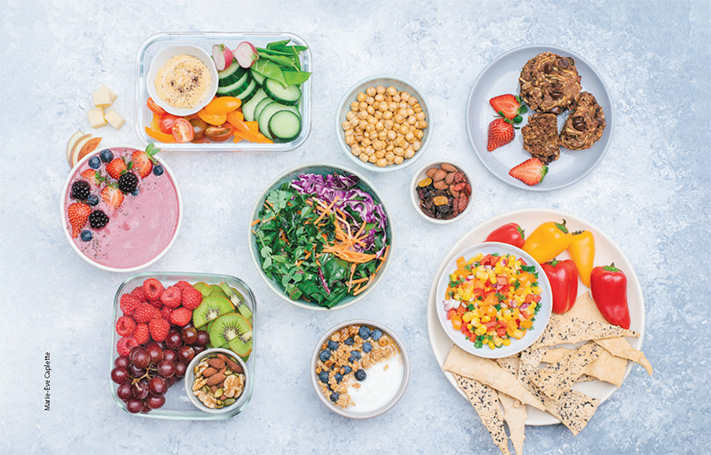
Nutrients: Components of food, including vitamins, minerals, proteins, sugars, and fats.


